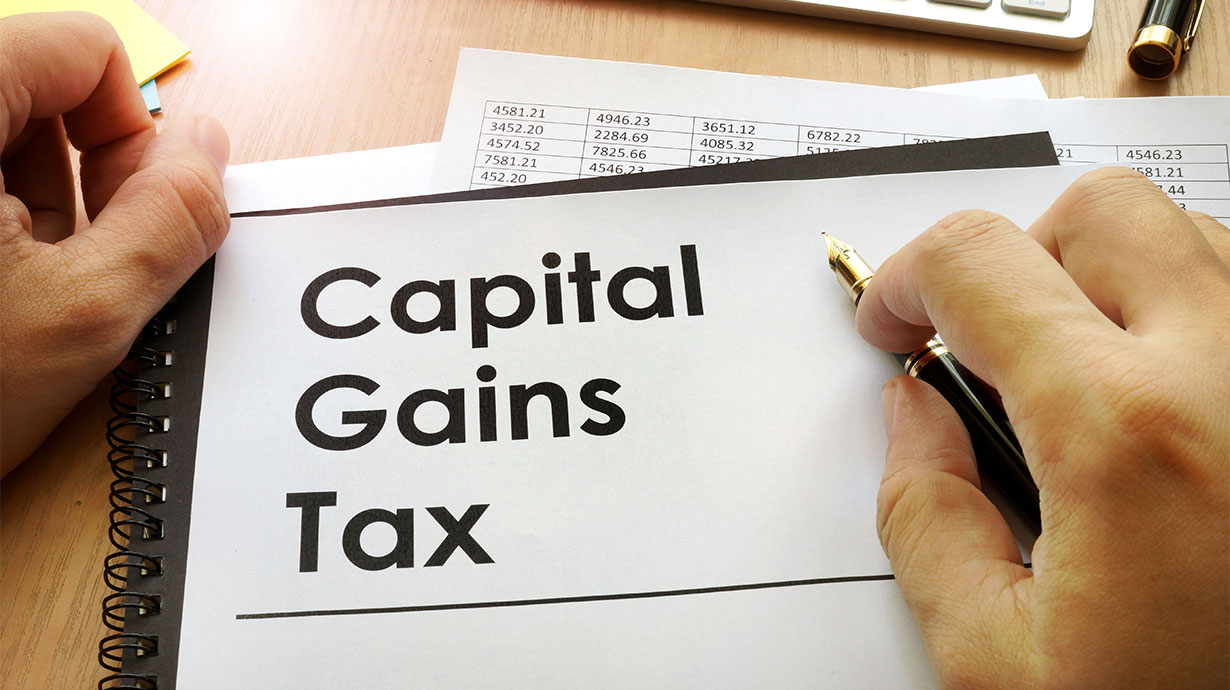Capital Gains Tax & What is Capital Gains Tax In India
What is Capital Gains Tax In India?
SAny profit or gain that arises from the sale of a ‘capital asset’ is known ‘income from capital gains’. Such capital gains are taxable in the year in which the transfer of the capital asset takes place. This is called capital gains tax. There are two types of Capital Gains: short-term capital gains (STCG) and long-term capital gains(LTCG).
Investment in a house property is one of the most sought out investments primarily because you get to own a house. While others may invest with the intention of earning a profit upon selling the property in the future. It is important to note that a house property is regarded as a capital asset for income tax purposes. Consequently, any gain or loss incurred from the sale of a house property may be subject to tax under the ‘Capital Gains’ head. Similarly, capital gains or losses may arise from sale of different types of capital assets. We will delve into the chapter on ‘Capital gains’ in detail here.
Defining Capital Assets
Land, building, house property, vehicles, patents, trademarks, leasehold rights, machinery, and jewellery are a few examples of capital assets. This includes having rights in or in relation to an Indian company. It also includes the rights of management or control or any other legal right.
The following do not come under the category of capital asset:
a. Any stock, consumables or raw material, held for the purpose of business or profession
b. Personal goods such as clothes and furniture held for personal use
c. Agricultural land in rural(*) India
d. 6½% gold bonds (1977) or 7% gold bonds (1980) or National Defence gold bonds (1980) issued by the central government
e. Special bearer bonds (1991)
f. Gold deposit bond issued under the gold deposit scheme (1999) or deposit certificates issued under the Gold Monetisation Scheme, 2015
*Definition of rural area (effective from AY 2014-15) – Any area which is outside the jurisdiction of a municipality or cantonment board, having a population of 10,000 or more is considered a rural area. Also, it should not fall within a distance given below
| Distance (to be measured aerially) | Population (as per the last census). |
| 2 kms from local limit of municipality or cantonment board | If the population of the municipality/cantonment board is more than 10,000 but not more than 1 lakh |
| 6 kms from local limit of municipality or cantonment board | If the population of the municipality/cantonment board is more than 1 lakh but not more than 10 lakh |
| 8 kms from local limit of municipality or cantonment board | If the population of the municipality/cantonment board is more than 10 lakh |
Types of Capital Assets?
1. STCA ( Short-term capital asset ) An asset held for a period of 36 months or less is a short-term capital asset.
The criteria is 24 months for immovable properties such as land, building and house property from FY 2017-18. For instance, if you sell house property after holding it for a period of 24 months, any income arising will be treated as a long-term capital gain, provided that property is sold after 31st March 2017.
The reduced period of the aforementioned 24 months is not applicable to movable property such as jewellery, debt-oriented mutual funds etc.
Some assets are considered short-term capital assets when these are held for 12 months or less. This rule is applicable if the date of transfer is after 10th July 2014 (irrespective of what the date of purchase is). These assets are:
- Equity or preference shares in a company listed on a recognized stock exchange in India
- Securities (like debentures, bonds, govt securities etc.) listed on a recognized stock exchange in India
- Units of UTI, whether quoted or not
- Units of equity oriented mutual fund, whether quoted or not
- Zero coupon bonds, whether quoted or not
2. LTCA ( Long-term capital asset ): An asset held for more than 36 months is a long-term capital asset. They will be classified as a long-term capital asset if held for more than 36 months as earlier.
Capital assets such as land, building and house property shall be considered as long-term capital asset if the owner holds it for a period of 24 months or more (from FY 2017-18).
Whereas, below-listed assets if held for a period of more than 12 months, shall be considered as long-term capital asset.
- Equity or preference shares in a company listed on a recognized stock exchange in India
- Securities (like debentures, bonds, govt securities etc.) listed on a recognized stock exchange in India
- Units of UTI, whether quoted or not
- Units of equity oriented mutual fund, whether quoted or not
- Zero coupon bonds, whether quoted or not
Classification of Inherited Capital Asset
In case an asset is acquired by gift, will, succession or inheritance, the period for which the asset was held by the previous owner is also included when determining whether it’s a short term or a long-term capital asset. In the case of bonus shares or rights shares, the period of holding is counted from the date of allotment of bonus shares or rights shares respectively.
Tax Rates – Long-Term Capital Gains and Short-Term Capital Gains
| Tax Type | Condition | Applicable Tax |
| Long-term capital gains tax (LTCG) | Sale of: – Equity shares – units of equity oriented mutual fund | 10% over and above Rs 1 lakh |
| Others | 20% | |
| Short-term capital gains tax (STCG) | When Securities Transaction Tax (STT) is not applicable | Normal slab rates |
| When STT is applicable | 15%. |
Tax on Equity and Debt Mutual Funds
Gains made on the sale of debt funds and equity funds are treated differently. Any fund that invests heavily in equities (more than 65% of their total portfolio) is called an equity fund.
| Funds | On or before 1 April 2023 | Effective 1 April 2023 | ||
| Short-Term Gains | Long-Term Gains | Short-Term Gains | Long-Term Gains | |
| Debt Funds | At tax slab rates of the individual | 10% without indexation or 20% with indexation whichever is lower | At tax slab rates of the individual | At tax slab rates of the individual |
| Equity Funds | 15% | 10% over and above Rs 1 lakh without indexation | 15% | 10% over and above Rs 1 lakh without indexation |
Tax Rules for Debt Mutual Funds
Recently in amendment to Finance Bill 2023, gains from debt mutual funds will now be taxed at slab rates and they will be considered as short-term irrespective of the holding period. Which means you will lose out the indexation benefit. Prior to 1st April 2023, debt mutual funds had to be held for more than 36 months to qualify as a long-term capital asset. It means you need to remain invested in these funds for at least three years to get the benefit of long-term capital gains tax. If redeemed within three years, the capital gains will be added to your income and will be taxed as per your income tax slab rate.
Would You Like a CA to Help You With Your IT Returns?
Get help on your income taxes and tax filing from us. Tax experts can prepare your tax returns and e-file within 48 hours. Plans start at Rs 2999 for taxpayers with capital gains and losses.
Calculating Capital Gains
Capital gains are calculated differently for assets held for a longer period and for those held over a shorter period.
Terms You Need to Know:
Full value consideration The consideration received or to be received by the seller as a result of transfer of his capital assets. Capital gains are chargeable to tax in the year of transfer, even if no consideration has been received.
Cost of acquisition The value for which the capital asset was acquired by the seller.
Cost of improvement Expenses of a capital nature incurred in making any additions or alterations to the capital asset by the seller.
Note:
- In certain cases where the capital asset becomes the property of the taxpayer otherwise than by an outright purchase by the taxpayer, the cost of acquisition and cost of improvement incurred by the previous owner would also be included.
- Improvements made before April 1, 2001, is never taken into consideration.
How to Calculate Short-Term Capital Gains?
Step 1: Start with the full value of consideration
Step 2: Deduct the following:
- Expenditure incurred wholly and exclusively in connection with such transfer
- Cost of acquisition
- Cost of improvement
Step 3: This amount is a short-term capital gain
| Short-term capital gain = | Full value consideration Less: Expenses incurred exclusively for such transfer Less: Cost of acquisition Less: Cost of improvement |
How to Calculate Long-Term Capital Gains?
Step 1: Start with the full value of consideration
Step 2: Deduct the following:
- Expenditure incurred wholly and exclusively in connection with such transfer
- Indexed cost of acquisition
- Indexed cost of improvement
Step 3: From this resulting number, deduct exemptions provided under sections 54, 54EC, 54F, and 54B
| Long-term capital gain= | Full value consideration Less : Expenses incurred exclusively for such transfer Less: Indexed cost of acquisition Less: Indexed cost of improvement Less: Expenses that can be deducted from full value for consideration* |
(*Expenses from sale proceeds from a capital asset, that wholly and directly relate to the sale or transfer of the capital asset are allowed to be deducted. These are the expenses which are necessary for the transfer to take place.)
Exception: As per Budget 2018, long-term capital gains on the sale of equity shares/ units of equity oriented fund, realised after 31st March 2018, will remain exempt up to Rs. 1 lakh per annum. Moreover, tax at @ 10% will be levied only on LTCG on shares/units of equity oriented fund exceeding Rs 1 lakh in one financial year without the benefit of indexation.
Deductible Expenses
A. Sale of house property: These expenses are deductible from the total sale price:
- Brokerage or commission paid for securing a purchaser
- Cost of stamp papers
- Travelling expenses in connection with the transfer – these may be incurred after the transfer has been affected
- Where property has been inherited, expenditure incurred with respect to procedures associated with the will and inheritance, obtaining succession certificate, costs of the executor, may also be allowed in some cases
B. Sale of shares: You may be allowed to deduct these expenses:
- a. Broker’s commission related to the shares sold
- STT or securities transaction tax is not allowed as a deductible expense
C. Where jewellery is sold: In case of sale of broker’s jewellery and where a broker’s services were involved in securing a buyer, the cost of these services can be deducted.
Note, that expenses deducted from the sale price of assets for calculating capital gains are not allowed as a deduction under any other head of income, and you can claim them only once.
Indexed Cost of Acquisition/Improvement
The cost of acquisition and improvement is indexed by applying CII (cost inflation index). It is done to adjust for inflation over the years of holding the asset. This increases one’s cost base and lowers the capital gains.
Refer to this page for the complete list of CII.
The indexed cost of acquisition is calculated as:
| Indexed cost of acquisition = | (Cost of acquisition X CII of the year in which the asset is transferred ) / CII of the year in which the asset was first held by the seller or FY 2001-02, whichever is later |
The cost of acquisition of the assets acquired before 1st April 2001 should be actual cost or FMV as on 1st April 2001, as per taxpayer’s option.
The indexed cost of improvement is calculated as:
| Indexed cost of improvement = | Cost of improvement x CII (year of asset transfer) / CII (year of asset improvement) |
Disclaimer:-
“All the information given is from credible and authentic resources and has been published after moderation. Any change in detail or information other than fact must be considered a human error. The blog we write is to provide updated information. You can raise any query on matters related to blog content. Also, note that we don’t provide any type of consultancy so we are sorry for being unable to reply to consultancy queries. Also, we do mention that our replies are solely on a practical basis and we advise you to cross verify with professional authorities for a fact check.”








